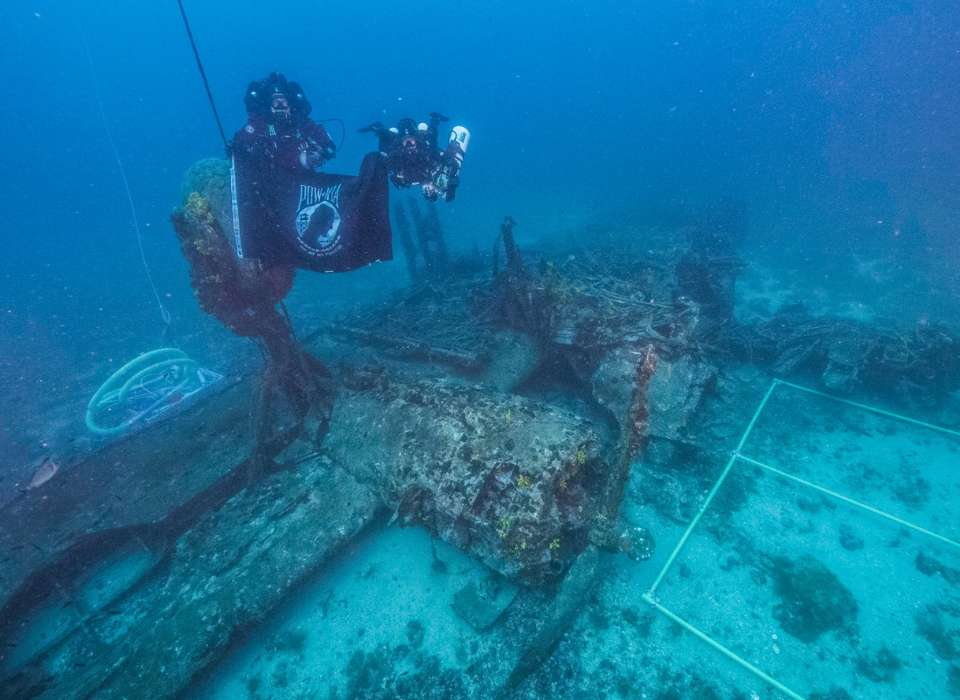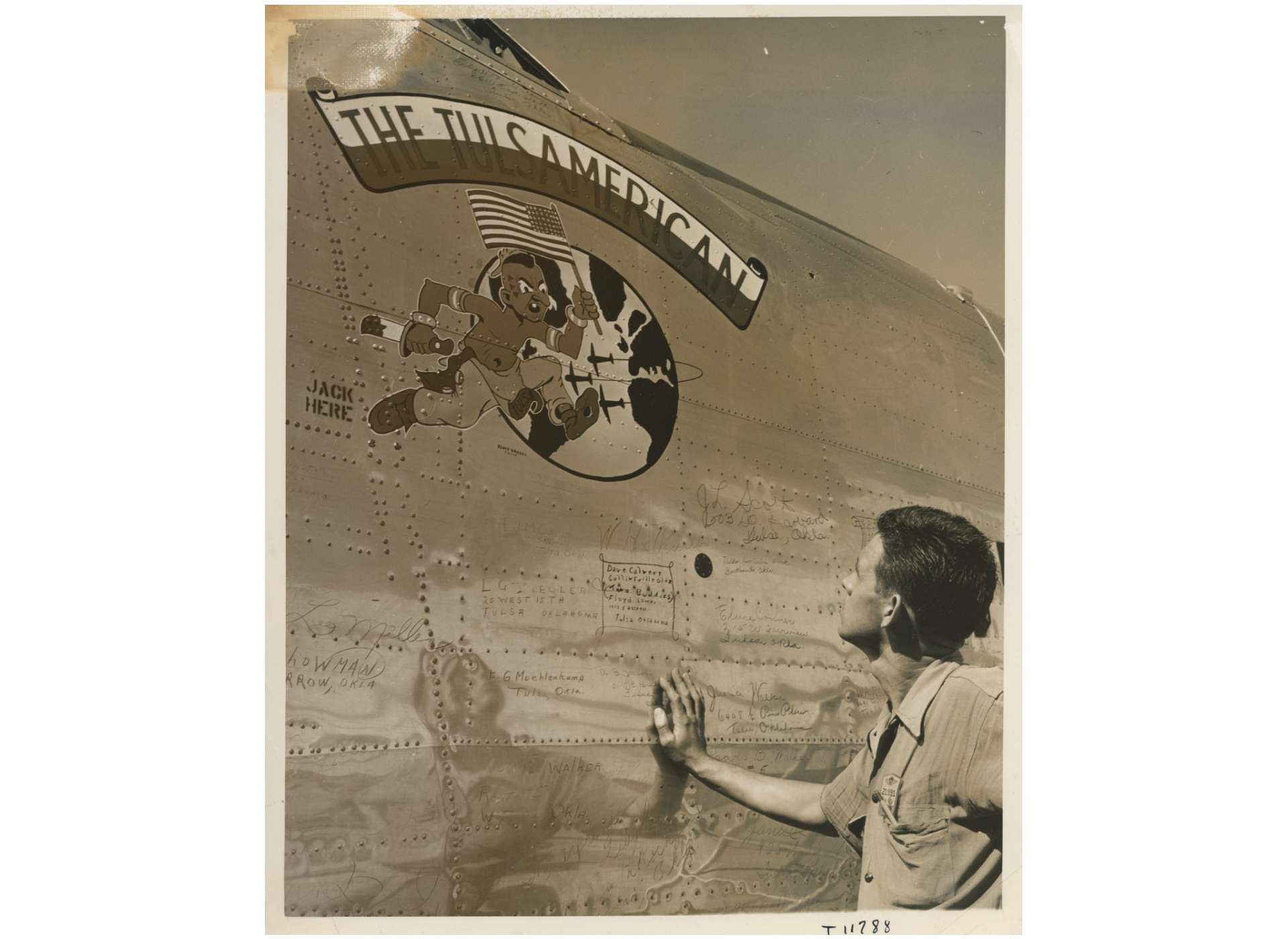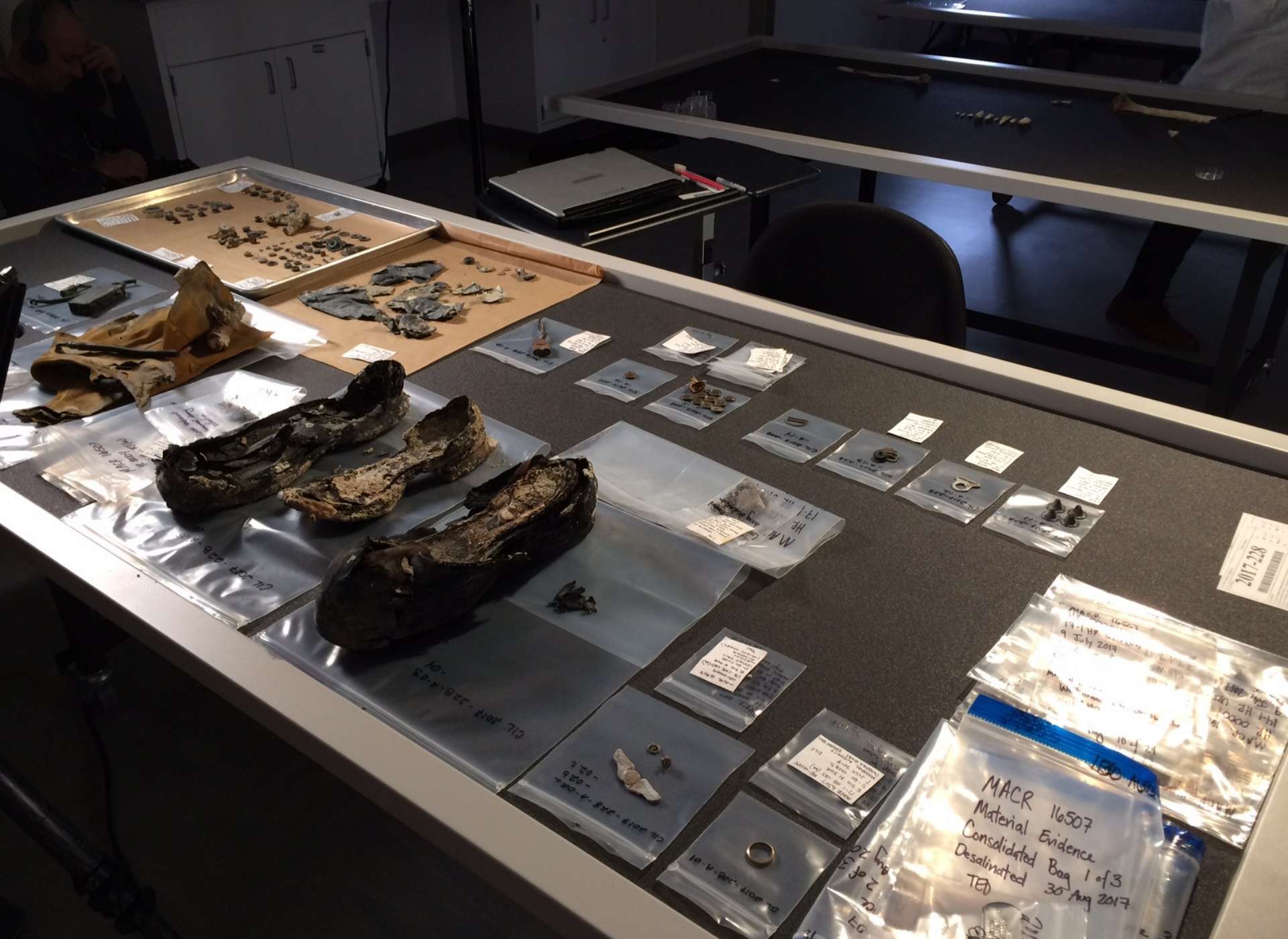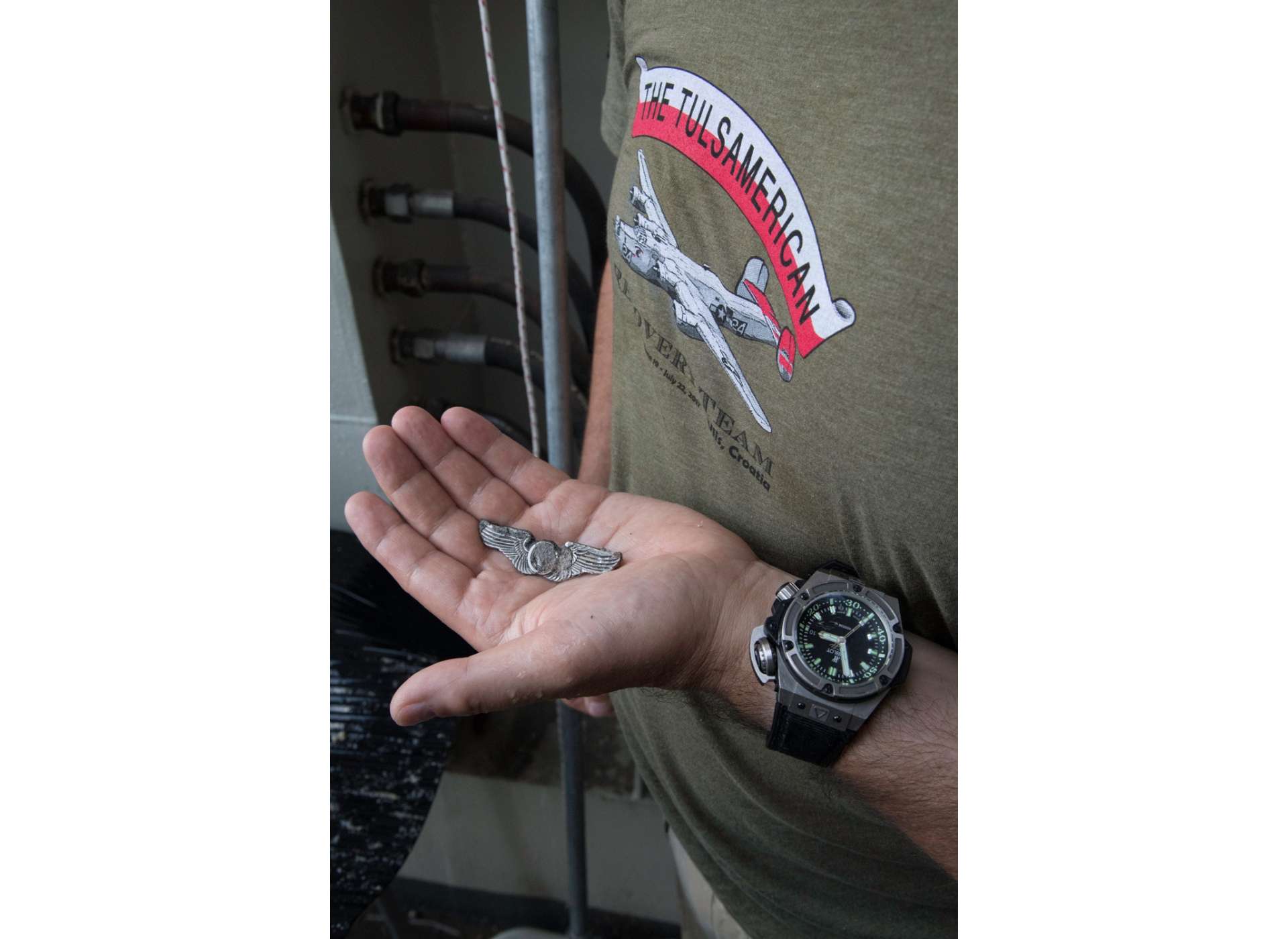In December 1944, the B-24 Liberator bomber Tulsamerican—the last B-24 built for World War II in Tulsa, Oklahoma, and paid for by the Home Front factory workers—fell from the sky while returning from a mission over Europe and disappeared beneath the waves of the Adriatic Sea. Seven crewmembers survived the crash and were rescued. Three men were never found, thought to be lost forever, unrecoverable.
NOVA, produced by WGBH in Boston, joined the US Department of Defense, the Croatian Navy, and an elite team of underwater archeologists and technical divers to excavate the plane's wreckage. The team embarked on a deep and dangerous expedition, racing the clock to determine what happened to the missing airmen with the hope of finally bringing them home. The episode, titled Last B-24, details an arduous, exacting dive and ensuing remains-identification process. An early emotional high point of the hour is the discovery of a wedding ring, more about which below.
Airing on PBS the evening of November 7 (check your local listings for the time; in New Orleans, the episode airs at 7:00 p.m. on WYES-TV), the episode also includes a segment on the lost P-51 of Tuskegee Airman Captain Lawrence Everett Dickson. The plane disappeared the same month Tulsamerican was lost during Dickson’s 68th mission, a reconnaissance flight over the Alps near the Austrian-Italian border. In summer 2017, teams from The National WWII Museum, the University of New Orleans, and University of Innsbruck joined the US Defense POW/MIA Accounting Agency (DPAA) to successfully identify the aircraft and recover some of Dickson’s remains.
The Museum, WYES, and WGBH will host an advance screening of the film at 6:00 p.m. November 5, to be followed by a panel discussion including filmmaker Kirk Wolfinger. Here's an email Q&A with Wolfinger:
Q: What are the production challenges of a film like this?
A: Any time you choose to make a film on the water, you are asking for trouble! Ask Kevin Costner (Waterworld). Those of us who have a track record for filmmaking/working on the water are gluttons for stress.
We had a number of things in our favor on this one that many underwater archeological and exploration programs don’t: The wreck had already been found! (That is always a crapshoot if you are still searching!) We were close to shore, so not subjected to the vagaries of ocean storms and heaving seas. We were in a beautiful location; the island of Vis has become a getaway vacation spot (not true in 1944).
Even with those things going for us, like all underwater explorations, there were many unknowns and questions to answer before we could call the exploration and the film successful. Depth is a killer: even at 140 feet, the Tulsamerican is a deep dive far beyond the limits of recreational diving. Moreover, it was a working dive, not a sightseeing trip. Underwater archeologists are scientists first and divers second. A distracted scientist/diver is a fatality waiting to happen. Enormous safety precautions and procedures were in place to make sure the Tulsamerican tragedy would not be increased 74 years after she went down by adding the life of a scientist or two. The film sequences articulate those precautions.
Pace is always an issue on an archeological assignment; in a terrestrial environment, a small team of archeologists could work a site like this over the course of a month and turn every stone. Underwater the clock is always ticking; even with three teams rotating bottom time, working time on the wreck was measured in minutes, not hours. Topside planning becomes critical. Selecting the most likely areas to discover the remains was essential, but still guesswork. When we looked in the most obvious location for the crew’s remains, we came up empty! (The film paints that picture.)
A large Croatian warship and her crew and a team of 16 scientists/divers are limited in time, money, and weather. Despite the enormous generosity of the Croatian navy and government, the pressure was on from first dive until we pulled anchor three weeks later. The film would be a good one, dramatic and compelling, by documenting the search and its trials and challenges; for the DPAA, success was measured strictly by finding the remains of the crew and being able to identify them and return them to their loved ones. We all knew—film crew, Croatian sailors, scientists, and dive team—that going home empty-handed was simply not an option. No one was going to be happy with less than a successful recovery.
How did you approach explaining the DPAA’s complicated process of IDing DNA?
Obviously, deciphering the DNA sequence and examining the human remains is the centerpiece of a great science show, and NOVA is the star of science television. Following the meticulous trail of the remains proscribed by the DPAA, we exhausted all the material evidence—such as artifacts and uniform insignias, bones, and teeth—that could tell us only that we had a military aircraft and that remains indicated a young male(s) between the age of 20 and 27. Since the three missing men all fell into that category, we really had not shed any new light on whom we had recovered.
-

The Tulsamerican's nose art.
-

Artifacts recovered from the Tulsamerican.
-

A member of the dive team displays a recovered artifact.
Not much more than a decade ago the case would have been closed and the remains would have been identified as possibly one of the three missing crewmen—leaving families to wonder if they had satisfying answers to their decades-old questions. The science behind DNA has changed all that. Now success is measured by identifying the individual specifically and returning that servicemember to his family. In the film, we follow the trail exactly in that way; a process of elimination as we work through the “obvious” clues and dig deeply into the science that can bring definitive closure. Not only does it make for a satisfying film ending, it was an emotional high point for all involved.
Is there a favorite moment in the episode?
The wedding ring was a high point for me. We had not discovered any human remains at that point, so the ring represented the first emotional artifact that had been recovered. Everyone who was working in that area was moved when Captain Nevin Kadice pulled the ring from the sediment and showed it to our Croatian archeologist to verify it. Remember, the Croatians were involved in their own very bloody war less than 20 years ago. For the Croatian sailors and scientists, this was poignant; many had lost loved ones in that conflict, and so helping to recover the remains of US servicemen, even 70 years later, had tremendous resonance for them. Something about the sentimental significance of a wedding ring was also moving; unlike any other piece of jewelry or clothing, the ring spoke of a connection to someone back home waiting for a reunion that would never happen. For the film crew, the ring was a critical story point: we knew the biographies of the three missing crewmen well, and we knew only one was married. Like a good crime-scene investigation, we thought we may have narrowed our search of possible victims down to one very specific individual.
The Dickson sequence seems like a great way to talk about the DNA angle. And because the dig and ID were successful. Is that why it’s in there?
The DPAA folks on the boat told me the story of the Dickson case while we were working on the Tulsamerican. It sounded like an incredible story but one we were too late to tell. Soon after our return, we learned the DNA identification was not yet resolved for Captain Dickson and we saw an opportunity to explain the science of DNA identification by including the story of Captain Dickson to run parallel to our identification of the crew of the Tulsamerican. After I met Marla Andrews, Captain Dickson’s daughter, I knew we had to tell his story. Even though she was only two at the time of his disappearance, her lifelong journey to find him and bring him home was so symbolic of the stories of the thousands of other families who are still waiting for answers and closure. Despite the 74 years that have passed and the many, many dead ends she had encountered, her good-natured persistence and relentless questioning paid off. I was enthralled as she told me her story during the interview. As the father of a US naval aviator, I understood at the very gut level why she never gave up. I intended to honor that by telling her story.
Reconstructing the missions really set the stage for the 70-year leap forward. How important is that the story, which is otherwise focused on the science of the digs and IDs.
In the age of drone warfare and high-performance aircraft firing missiles and dropping bombs at great distances we, the public, can forget (if we ever understood), what the air war during World War II was like in the skies over Europe. These planes were not built for comfort! Missions were cold, miserable, and long affairs with the distinct potential of dying in a fireball free fall from 20,000 feet. The enlisted crewmembers were 18- and 19-year-old kids, and the navigator, bombardier, and copilot officers maybe 21 or 22? The “Old Man” pilot was perhaps 23 or 24. In our NOVA episode, we tell three stories of three different airmen who made the ultimate sacrifice; each one left behind family members who have waited seven decades to get some kind of resolution to their final chapter. Reconstructing the missions, retelling these stories, is NOVA’s way of doing what the DPAA is doing with their boots on the ground every day. It’s our cinematic way of saying, “We will never forget.”



